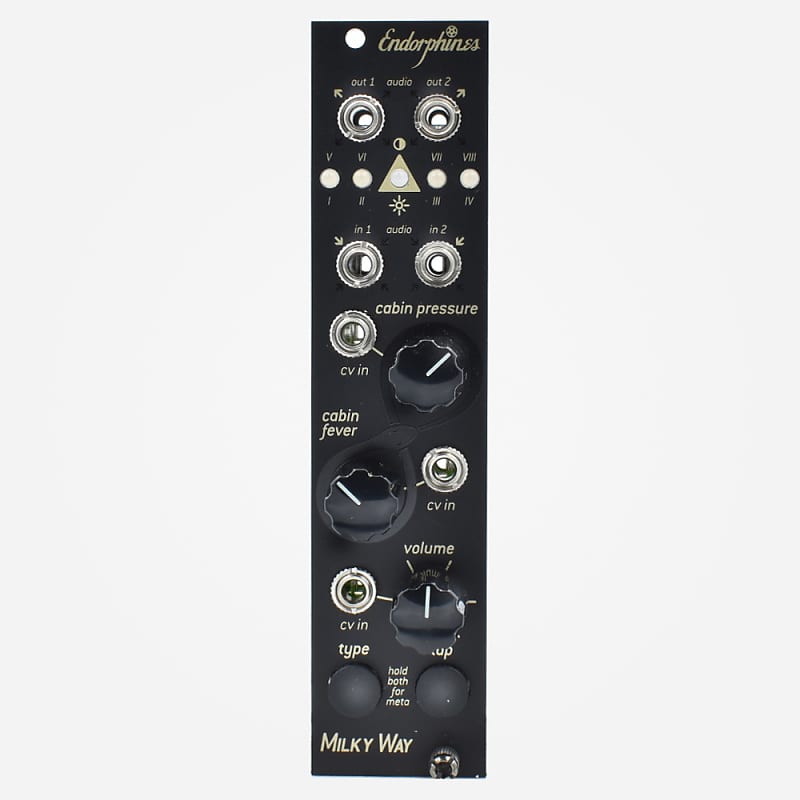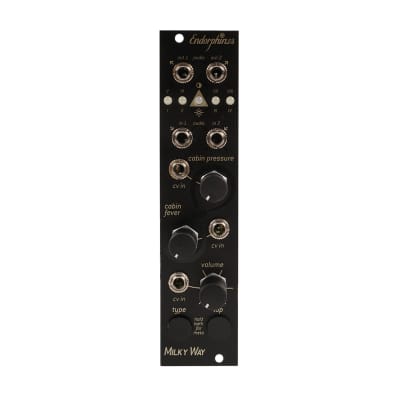Based on the Cabin Pressure controls on the Grand Terminal and BLCK_NOIR, Milky Way is an excellent sounding and compact stereo multieffect module featuring 16 different effect modes, CV effect selection, and integrated VCA for the output!
The included effects:
• HALL REVERB: ‘Cabin fever’ knob defines the decay of the reverb or hall size. Holding ‘tap’ for longer than 1 second enables the secondary function for ‘cabin fever’: fixed hi-pass filter to cut off low frequencies and have more ‘air’ in the final output.
• SHIMMER REVERB is a variation of the hall reverb with a pitch shifter to create choir-like, huge and unrealistic spaces. The primary ‘cabin fever’ function defines the decay and the secondary function defines the amount of pitch-shifter mixed into original reverb.
• STEREO ROOM REVERB recreates a sort of stereo room ambience. Primary ‘cabin fever’ parameter defines room size and the secondary defines the stereo spread of the reverb, from mono up to a huge stereo spread.
• PLATE REVERB. The primary ‘cabin fever’ defines the decay of the reverb. In real life equivalent this is the distance from the pickups to the metal plate which is how long the tail of the reverb is present. Secondary parameter defines the amount of pre-delay to distant sounds in ambience.
• SPRING REVERB. The primary ‘cabin fever’ defines the decay of the reverb. With the ‘tap’ button you can simulate a sound as if you pluck the real spring with your finger. The secondary function is tied to the ‘tap’ button’s ‘pluck the spring’ feature and defines the decay of how fast the spring will calm down after manually plucking it.
• PING-PONG DELAY is a stereo clocked delay. A ‘tap’ is usually three or more short clicks on the ‘tap’ button. The primary ‘cabin fever’ parameter defines the feedback of the delay or repeats. The secondary defines the clock division of the incoming tap/clock: 1, 3/4, 2/3, 1/2, 1/3, 1/4, 1/8
• TAPE ECHO is a delay with 3 fixed playback heads. Primary ‘cabin fever’ parameter defines the delay repeat rate which is the speed of tape. The ‘tap’ button works in a limited frequency range of manual tapping and defines the amount of feedback. The secondary works as a divider for the incoming clock.
• CHORUS: Primary ‘cabin fever’ knob defines the feedback amount. In average amounts, it creates typical unison effect however in full CW it goes to an infinite feedback resulting unrealistic ambient. Secondary parameter defines the modulation depth, which is 'full on' by default.
• GATED REVERB is based around plate reverb with noise gate. The primary ‘cabin fever’ defines the reverb decay, but the secondary defines the threshold of the noise gate. Noise gate’s attack and decay are fixed and chosen experimentally to fit most musical styles.
• FLANGER: The ‘cabin pressure’ knob sets the amount of delay. With primary ‘cabin fever’ we set the LFO speed. The secondary defines the feedback. Playing with that three parameters allows to achieve sweeping, airplane engine alike sound with a pretty wide range.
• RING MODULATOR multiplies the signal with an internal sine wave oscillator. ‘Cabin pressure’ defines the amount of modulation and ‘cabin fever’ defines the speed of the oscillator. Secret ingredient – feedback! Its amount is controlled by the secondary ‘cabin fever’ and brings special dirtiness to the sounds.
• OVERDRIVE: ‘Cabin pressure’ knob adjusts the drive amount with volume compensation, while ‘cabin fever’ defines the tone control as usually found in guitar pedals. The ‘tap’ button makes the effect active or bypassed, like the switch on a guitar pedal – and so does ‘cabin fever’ latching trigger CV input.
• PEAK COMPRESSOR: ‘Cabin pressure’ knob defines the threshold from -90dB to 0dB (fully CW). Primary ‘cabin fever’ sets the amount of gain reduction (ratio) from 1 to 25. Secondary parameter defines the attack, from 1 to 200 msec. Release is always ‘auto’. ‘C. fever’ CV input is an unattenuated side-chain input.
• FREEZER/LOOPER: When ‘tap’ is pressed (or ‘cabin fever’ CV gate is ON), the audio is looped by the grain length defined by the ‘cabin fever’ knob – and with the speed – defined by ‘cabin pressure’ knob or CV – applied.
Specifications:
- 120 mA +12V
- 15 mA -12V
- 0 mA 5V
- 30 mm deep




